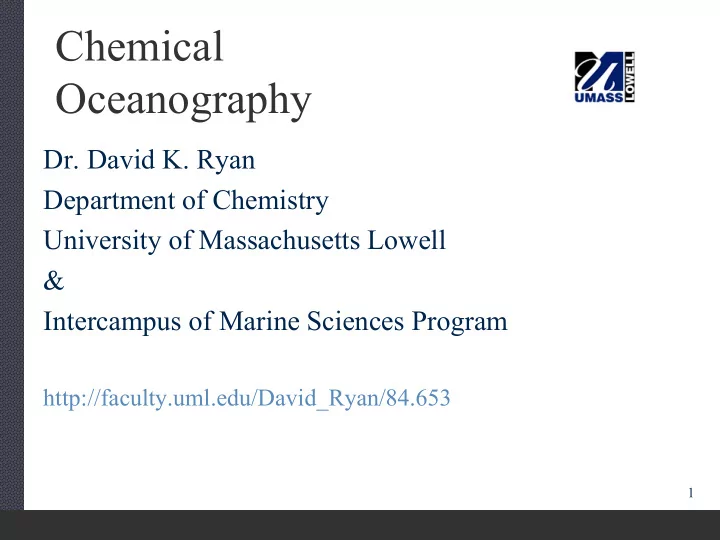

Chemical Oceanography Dr. David K. Ryan Department of Chemistry University of Massachusetts Lowell & Intercampus of Marine Sciences Program http://faculty.uml.edu/David_Ryan/84.653 1
Water – Amazing Stuff 2
Chemical Oceanography Physical Chemistry of Seawater (E&H Chap. 3) Seawater is 96.5 % H 2 O Water unique substance & solvent Review structure Discuss selected unusual properties Consequences of water anomalies Phase diagrams 3
Hydrogen Bonding is key to anomalous properties of water H-Bonding results from polarity 4
Dipole & Quadrapole Diagrams (Millero 2006) p. 125 5
6 Arrangement for Hydrogen Bonding - Pentamer
Water Clusters Dynamically Form, Break and Re-form Frank & Wen Flickering Cluster Model 7 (Millero 2006)
Millero 8
Water Properties High Heat Capacity (C p ) (Heat energy to raise 1 g of water 1 o C) Prevents extreme ranges of temperature (temp buffering) Allows heat transfer by water masses to be large 9
Water Properties High Heat of Fusion ( ∆ H = 79 cal/g) (Heat energy for melting solid) Absorption or release of latent heat results in high thermostatic effect a.k.a. Enthalpy of Fusion (kJ/kg) 10
Water Properties High Heat of Vaporization ( ∆ H = 540 cal/g) (Heat energy for evaporating liquid) Highest of all liquids Results in evaporative cooling and transfer of heat to atmosphere, thermostating a.k.a. Enthalpy of Vaporization 11
Large Quantities of Heat are Absorbed & Released During Phase Changes 12 (Wiley 1999)
Water Properties Thermal Expansion (temperature of maximum density) Waters with low or no salt content have maximum density above freezing points Ice floats 13
Simple Phase Diagram of Water (Wiley 1999) 14
Water Properties High Dielectric Constant (highest of almost all substances) Results in charge insulating power Important in dissolution of salts Important in hydration of ions 15
Water Properties Relatively High Viscosity (high for low molecular weight substance) Important in wave and current formation 16
Water Properties High Surface Tension (highest of all substances) Controls drop formation, important in waves and many surface properties Important in cell physiology 17
Interfacial Tension creates appearance of a “skin” on surface 18
Water Properties High Heat Conduction (highest of all liquids) Important for small scale heat transfer as in cells 19
Water Properties High Transparency (absorption of radiant energy high in IR and UV) Water is colorless Important in photosynthetic and photochemical processes 20
21
Water Properties Low Electrolytic Dissociation (neutral molecule containing some OH - and H + ) Autodissociation of water important in acid-base chemistry, many geological and biological processes 22
Water Properties Low Compressibility (similar to solids) Little change in density as pressure increases with depth 23
Simple Phase Diagram of Water (Wiley 1999) 24
Detailed Phase Diagram of Water Showing Forms of Ice (Atkins 1990) 25
26
Structure of Ice 1h with water pentamer highlighted (Emerson & Hedges Fig 3.4, page 67) 27
Structure of Ice 1h, Hexagonal with Space Giving Low Density (Pilson 1998) 28
Comparison of Ice and Liquid Water Structures (NYU-SVL) Ice 1h Liquid Water 29
Water Clusters Dynamically Form, Break and Re-form (Millero 2006) 30
Structure or Association of Water Molecules Versus Temperature and Affect on Density (Libes 1992) 31
What happens when we add solutes to water? “Water, water, every where, Nor any drop to drink.” The Rime of the Ancient Mariner Samuel Taylor Coleridge Circa 1798 32
Solutes (Particularly Ions) are Structure Breakers More accurately they form new structures Reorient some water molecules Cause new associations Modify properties Alter much of the Physical Chem. (Physicochemical Properties) 33
Temperature Density Diagram for Pure Water & Seawater Salinity of 35 (Pilson 1998) 34
Some Properties Undergo Dramatic Changes 35
Adding an Ion Like Sodium (Na + ) Changes Some Things in H 2 O Polarity, High Dielectric Constant Result in Strong Solvation or Primary Hydration of Na + by H 2 O Solvation Shell of H 2 O 36
Secondary Solvation Shell or a Second Sphere of H 2 O is Bound to the First 37
Normal H 2 O Structure Exists Out Here for “Bulk” Water Disrupted Water Structure Exists in Here 38 Bulk Water Bulk Water
(Emerson & Hedges Fig 3.6, page 69) 39
Hydrated Ion Primary (Morel 1993) solvent Secondary solvent = H 2 O Bulk Disordered = cation Solution solvent 40
For Anions the Concept is Analogous Only Reversed With Respect to the Orientation of the H 2 O 41
Long Range (Non-Specific) Attraction δ – Other Oriented Outward Effects Also Long Range Occur (Non-Specific) Repulsion δ + Oriented 42 Outward
Recommend
More recommend